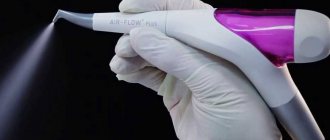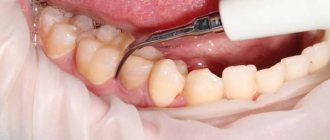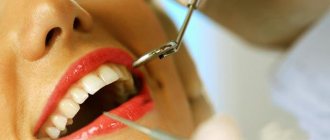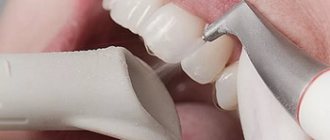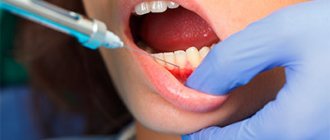Human health depends on many factors, including the condition of teeth. Insufficient oral hygiene leads directly to the occurrence of dental diseases. Even with the most thorough brushing with a toothbrush using high-quality toothpastes, it is not always possible to remove all unwanted deposits. To do this, dentists recommend visiting the clinic at least a couple of times a year for a professional cleaning procedure. Among all the options presented, it is sometimes difficult to choose the one that will give the maximum effect and at the same time, will not harm the teeth.
What is ultrasonic cleaning
Ultrasonic teeth cleaning is a procedure for removing plaque and tartar by a dentist. Currently this is the most popular and affordable procedure. During it, the specialist picks up a special skyler. The device creates ultrasonic waves and vibrations of a special frequency that destroy pathogenic deposits, and they are quietly removed from the enamel. Thanks to the use of ultrasound, cleaning is quick and painless for the patient.
Thanks to this procedure the patient:
- Undergoes oral cavity sanitation;
- Lightens enamel by 1-2 tones. This is why many patients confuse this cleaning with regular whitening.
Like any other procedure, ultrasonic teeth cleaning has both pros and cons.
Its main positive qualities are that the patient here:
- Can remove plaque located in gaps and hard-to-reach places;
- May lighten enamel. This cleansing will be especially useful for heavy smokers;
- Does not seriously injure its enamel, soft tissues, i.e. there is no direct contact between the surface of the teeth and the working attachment;
- Can polish teeth well and lighten them by 1-2 tones;
- Completely gets rid of unpleasant odor;
- Must pay 2000 rubles.
In addition to the advantages, this procedure also has several disadvantages.
For example, here is a patient:
- 1-2 days after cleansing, you may react acutely to cold and hot drinks;
- You should seek help only from an experienced specialist who will clean the tooth surface and not injure it;
- Before agreeing to cleanse, you should first study the list of contraindications.
Remember: the effect after such cleaning lasts 1 year.
After this, the teeth darken again and become covered with pigment from food dyes and tobacco. But often such cleaning cannot be done, because... the enamel needs to be restored.
Also, do not forget that not all citizens undergo ultrasonic facial cleansing.
It is performed only on patients who:
- The enamel becomes very dull, loses its original color, and pigmented spots of a dark yellow or brown hue often appear;
- Often there is an unpleasant odor from the mouth that does not go away even after brushing your teeth;
- There are prerequisites for the development of caries and periodontitis;
- The gums bleed and gingivitis often appears.
In addition, it is also performed on patients who will have to undergo artistic dental restoration in the future. Before it, the patient must undergo cleaning.
Ultrasonic cleaning is not performed on patients with:
- Asthma, bronchitis, various cardiovascular disorders;
- Epilepsy, other neurological pathologies;
- Any inflammatory processes in the acute stage;
- Pacemaker;
- Installed implant, fixed dentures;
- Chronic nasal congestion.
It is also not performed on children under 6 years of age, i.e. children with baby teeth and adolescents under 18 years of age.
Remember: pregnant ladies can undergo ultrasonic cleaning only after consulting their doctor.
Ultrasonic cleaning. Who is it suitable for?
The procedure is carried out using special equipment using various attachments. Tartar is destroyed by vibration. The efficiency depends on the size of the skeller nozzle. The optimal size is determined based on the amount of deposits that need to be removed.
Unpleasant sensations during ultrasonic cleaning are practically eliminated. There is no need to use anesthesia, which is very convenient. When the patient still feels some discomfort, the dentist can reduce the amplitude and frequency of vibrations. What sets this cleaning apart is its safety, because the risk of injury to the gums and damage to the enamel is minimized.
The ease of implementation will allow you to spend a minimum of time in the dentist's office. After examining the oral cavity, if there are no contraindications, you can begin. To do this, a special gel is applied to the surface of the teeth. Under the influence of the skeller, it releases oxygen, which will actually destroy unwanted deposits. It is noteworthy that with this method of professional cleaning, not only the tooth surface itself is cleaned, but also the periodontal and root canals. This further significantly reduces the risk of dental disease. At the end of the procedure, the doctor most often performs polishing using a special paste or fluoridation of the enamel.
Indications and contraindications
Despite all the assurances about the complete safety of ultrasonic cleaning, there are some contraindications to its implementation. Therefore, it is important to better study the indications for the procedure and possible obstacles before contacting the clinic.
So, you may need ultrasonic cleaning if you observe:
- bad breath;
- tartar, plaque;
- swelling of the gums, deposits under them, bleeding;
- sharp staining of the enamel after consuming products with bright dyes.
This is just a small list of factors that indicate poor oral health. It is optimal not to wait for further symptoms, but to immediately seek advice. The initial stage of many diseases can be easily eliminated by ordinary professional ultrasonic cleaning. This will help in the future to avoid artistic restoration and prosthetics.
But, there are factors that will not allow the dentist to clean tartar efficiently and safely with a skeller. This:
- inflammatory processes;
- viral infections;
- exacerbation of chronic diseases;
- increased sensitivity;
- childhood and adolescence.
Most of these factors can be easily eliminated, so ultrasonic cleaning will not have to be put off for a long time.
Stages of the procedure
In general, ultrasonic cleaning is carried out in several main stages.
- Examination of the patient’s oral cavity, checking its problem areas, the degree of plaque.
- Numbing problem areas, but numbing them if necessary.
- Skyler. In this case, the device has two operating modes. The procedure is carried out with a thin stream of water or dry. The power of impact is also determined by a specialist.
- Treatment of teeth, grinding them with a drill and a special attachment. They can also be sanded with hand tools.
- Covering each tooth with fluoride-containing gel and varnish. It reduces the sensitivity of the enamel for 2-3 days.
What is Air Flow
Air Flow is translated as “air flow”. This is a professional teeth cleaning method. During the procedure, a special Air Flow sandblasting machine is used. The specialist treats the enamel with a special solution, which is supplied in the form of a jet under high pressure.
The composition includes sodium bicarbonate and oxygen. The uniqueness of this composition is that it does not damage the upper protective layer of teeth.
The device includes two independent channels:
- The first one supplies abrasive powder mixed with water;
- The 2nd transmits a powerful air flow.
Thanks to this powerful effect, bacteria and food debris peel off from the enamel. Remember: Air Flow only removes mild plaque.
At the same time, the specialist carefully treats each tooth, carefully removing pathogens from the most inaccessible places, periodontal pockets.
Air Flow teeth cleaning is carried out only for those patients who:
- A dense plaque forms on the teeth;
- The color of the enamel changes;
- Teeth are crowded, so they cannot use other methods of cleaning interdental spaces;
- There have been several courses of orthodontic treatment using braces;
- In the future there will be professional teeth whitening, implantation, and prosthetics.
Remember: experts recommend doing this procedure 2 times a year.
This is the only way your teeth will remain clean for a long time after air flow. In general, it is made by heavy smokers and coffee lovers.
In addition, experts do not recommend Air Flow teeth cleaning for patients with:
- Periodontal disease. Such patients cannot undergo the procedure, because after air flow, they may bleed, the gums will swell, swell;
- An impressive amount of dental plaque. Remember: the device does not help get rid of deep and hardened dental plaque. In this case, it is better to carry out ultrasonic cleaning of the enamel;
- Pathological condition of the respiratory system;
- Allergy to citrus fruits.
Remember: patients on a salt-free diet are also not subject to this procedure.
It can be done to pregnant and lactating women, but only after consultation with a specialist.
Like any other procedure, Air Flow teeth cleaning has advantages and disadvantages.
Its positive qualities are that here the patient:
- Does not feel pain during the procedure or severe discomfort;
- And the mucous membrane of the mouth does not come into contact with the device, so the patient’s enamel is not injured during the procedure;
- During the procedure, it can clean even hard-to-reach places;
- Sees results after the first session;
- Goes through a procedure that uses non-toxic, harmless components;
- During the procedure, it can even enrich your enamel with fluoride.
The disadvantage of this procedure is that:
- After air flow cleaning, the enamel becomes unnaturally white. Others may think that the person has undergone bleaching;
- Here, not only plaque and age spots are removed, but the natural shade of the teeth does not change.
In addition, do not forget that a specialist may injure the mucous membrane during the procedure. But this rarely happens.
Which method should you choose?
Each teeth cleaning option has its own advantages and disadvantages. Air flow cleaning takes longer, is excellent for soft plaque, and is suitable for systematic teeth cleaning once every six months. It is less traumatic for the gums, so it can be used in patients suffering from periodontal disease.
With the help of ultrasound, the quality of cleaning is higher; the hygienist can remove dense plaque and old tartar. But at the same time, the method has a number of contraindications that must be taken into account before cleaning.
A preliminary consultation with a hygienist is of great importance in this matter. At the Constellation Family Dentistry Center, they carry out both options for professional teeth cleaning: before starting the procedure, a specialist assesses the condition of the oral cavity and, depending on the changes, recommends the most suitable cleaning option.
Stages of the procedure
Air Flow teeth cleaning is carried out in several main stages.
Specialist:
- Covers the patient's lips with Vaseline. This will prevent them from drying out.
- Places a saliva ejector in the patient's mouth. It gets rid of saliva, which is actively released during the procedure.
- Puts a special hat and glasses on the patient. They protect the face and hair from small particles and abrasive powder used when brushing teeth.
- Carefully treats each tooth. It is important that the jet does not hit soft tissues or dentin. With caries and erosion, the patient may experience discomfort.
- Covers treated enamel with a fluorine-containing compound. It consolidates the resulting effect.
Remember: the force of the jet pressure is controlled by the dentist independently.
This is how it controls the force applied to soft and hard deposits. Thanks to this, the procedure becomes more effective. In this case, plaque and food debris are carefully removed, the patient does not feel any pain.
It is also a good prevention of caries.
